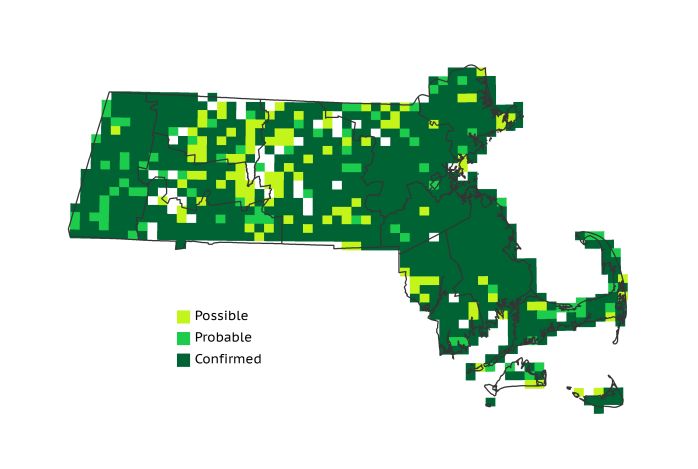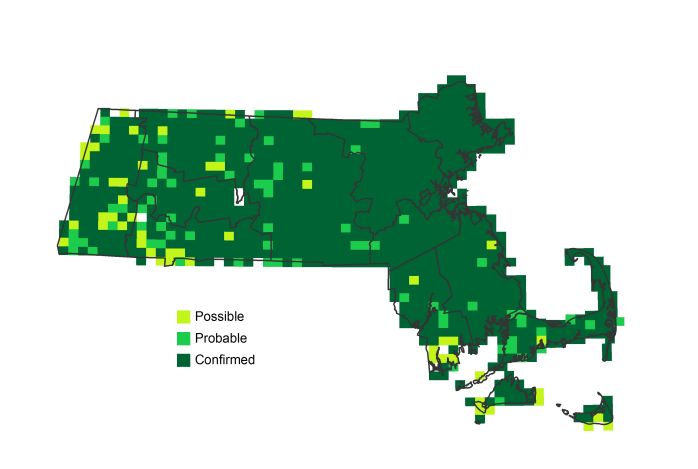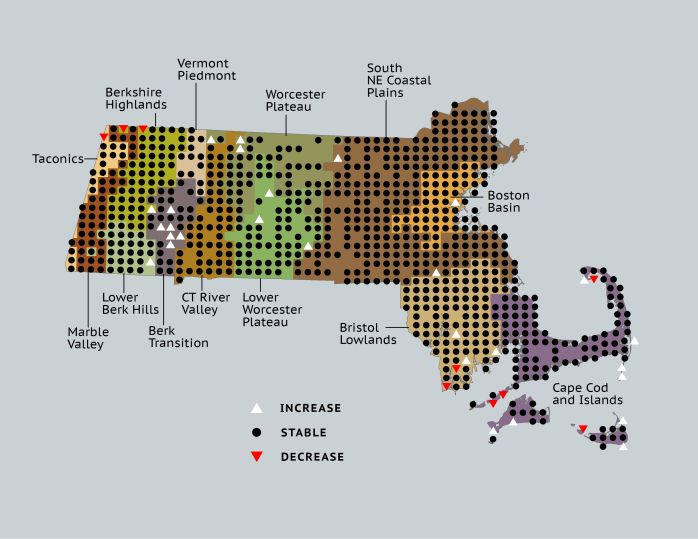Find a Bird
Common Grackle
Quiscalus quiscula

Nearly ubiquitous and stable
Action/monitoring needed
“To claim, at a dead party, to have spotted a grackle, / When in fact you haven’t of late, can do no harm.” Richard Wilbur, “Lying”
Cereal grains are a favorite food of the Common Grackle, a consummate survivor whose glossy plumage and harsh voice are familiar to farmers and urbanites alike. They can breed in almost any sort of habitat – swamps, fields, riparian woods, beaches, grasslands, shrublands, and human settlements are all readily used. The only habitat type grackles don’t seem to thrive in is dense old-growth forest, which means that Common Grackles probably were not all that common in most of Massachusetts before Europeans showed up. These gregarious blackbirds have ridden humanity’s coattails to the point of unprecedented prosperity, but despite this they show signs of declining abundance in the Breeding Bird Survey.
Historic Status
The Crow Blackbird, as it was known for a long time, also went by the secondary name of “grakle,” without the “c,” but eventually came to be known as the “Purple Grackle.” It also came to be known as a pest, a crop raider, and an eater of the eggs of other species, and as such it underwent severe persecution by humans in the earliest days of bird study in Massachusetts. Nonetheless, its population has remained strong despite both people’s attacks and sweeping habitat changes through time. The species’ prosperity was noticed by William Brewster, who wrote, “By far the largest colony which has existed anywhere in the Cambridge Region within my recollection was established in the Fresh Pond Swamps in the spring of 1889. There were only a few birds at first, but they continued to spread and increase until by 1898 there must have been upwards of two hundred of them,” (Brewster 1906).
Atlas 1 Distribution
Common Grackles lived up to their name in Atlas 1, and were very widespread as breeders in Massachusetts, occupying 93% of the blocks surveyed. The western highlands were a nearly solid block of occupancy through to the Berkshire Transition, where several blocks found no evidence of breeding grackles. The center of the state showed a number of similar gaps in the bird’s otherwise nearly solid distribution, though disparities in survey effort may be partially responsible for these gaps. The Common Grackle’s aversion to mature woodland that has no gaps may explain some of its absence from parts of the Worcester Plateau, although survey coverage may also be to blame in that area. Throughout the eastern regions of the state, grackles were nearly ubiquitous and missing only from a few scattered, single blocks, reaching their lowest density on the Cape and Islands – 84%.
Atlas 2 Distribution and Change
Fortunately able to adapt to urban life, the Common Grackle has managed to remain at a near saturation level in the state and was found in 95% of the blocks surveyed. The breeding footprint of this species includes most of the Commonwealth, and this persistence has not been offset by notable losses in footprint – in fact, grackles managed to eke out a net gain in the number of blocks occupied.
Atlas 1 Map

Atlas 2 Map

Atlas Change Map

Ecoregion Data
Atlas 1 | Atlas 2 | Change | ||||||
Ecoregion | # Blocks | % Blocks | % of Range | # Blocks | % Blocks | % of Range | Change in # Blocks | Change in % Blocks |
Taconic Mountains | 16 | 100.0 | 1.8 | 17 | 68.0 | 1.7 | -1 | -6.7 |
Marble Valleys/Housatonic Valley | 39 | 100.0 | 4.4 | 39 | 100.0 | 4.0 | 0 | 0.0 |
Berkshire Highlands | 53 | 96.4 | 5.9 | 53 | 96.4 | 5.4 | -1 | -1.9 |
Lower Berkshire Hills | 26 | 92.9 | 2.9 | 29 | 93.5 | 2.9 | 1 | 3.7 |
Vermont Piedmont | 15 | 88.2 | 1.7 | 17 | 100.0 | 1.7 | 0 | 0.0 |
Berkshire Transition | 31 | 81.6 | 3.5 | 38 | 95.0 | 3.9 | 6 | 19.4 |
Connecticut River Valley | 55 | 98.2 | 6.1 | 62 | 95.4 | 6.3 | 0 | 0.0 |
Worcester Plateau | 69 | 88.5 | 7.7 | 85 | 96.6 | 8.6 | 3 | 6.3 |
Lower Worcester Plateau | 63 | 85.1 | 7.0 | 78 | 97.5 | 7.9 | 3 | 5.6 |
S. New England Coastal Plains and Hills | 260 | 96.3 | 29.0 | 281 | 99.3 | 28.6 | 2 | 0.9 |
Boston Basin | 53 | 94.6 | 5.9 | 54 | 96.4 | 5.5 | 1 | 1.8 |
Bristol and Narragansett Lowlands | 102 | 96.2 | 11.4 | 106 | 93.0 | 10.8 | 1 | 1.0 |
Cape Cod and Islands | 114 | 83.8 | 12.7 | 125 | 86.8 | 12.7 | 4 | 3.3 |
Statewide Total | 896 | 92.5 | 100.0 | 984 | 94.9 | 100.0 | 19 | 2.3 |
Notes
Despite this apparent growth in their breeding footprint, the Breeding Bird Survey (BBS) shows significant declines in abundance for the Common Grackle in Massachusetts, the New England/Mid-Atlantic Region, and the Eastern US overall. They fall into our “whispering bird” category – those species with a demonstrated stable or increasing breeding footprint from Atlas 2 data, but also a demonstrated decline in abundance from the BBS. This drives our final assessment that this is a species with a need for further monitoring and conservation action.



